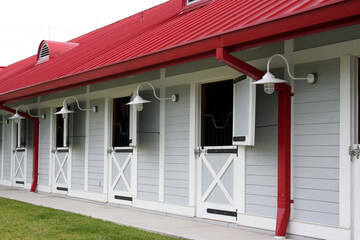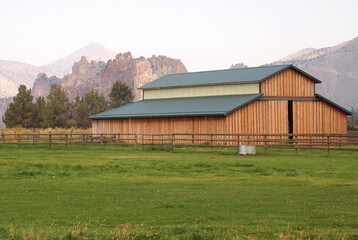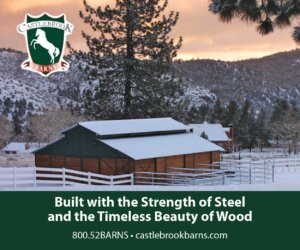Exterior Colors are Important for Beauty and Comfort
By Nikki Alvin-Smith for Horizon Structures

There are many decisions to make when building a new barn. One of the less-thought-about options is often the barn color.
The selection of the perfect exterior color for the new barn at your property hinges partly on what already exists structure-wise that it should complement. Color can also affect the use of the building and the comfort of your horses.
Originally, horse barns and agricultural buildings in general weren’t painted at all. In the Northeastern USA early settlers were just happy to have wood to build the barn and shelter for their grain and livestock. Naturally, the weather took its toll on the untreated wood and by the 1700s farmers were figuring out their structures needed some sort of protection from rain, sun and snow.
We’ve all seen the traditional red/brown barns across the American countryside. How did this color become so common? Barns in Scandinavia and Europe, in general, were painted in rusty brown/red colors — perhaps to create the appearance of red brick, which was considered a building material of the wealthy. The early settlers, whether of Dutch, Scandinavian or other origins, devised their own red paint utilizing what was readily and cheaply available to them.
The paint mixture was made of lime, red iron oxide and skimmed milk! Red iron oxide is more commonly known as rust. Amazingly, this innovative product was later improved by the addition of linseed oil, which transformed the plastic-like coating to a product that could actually soak into the wood and thus further protect it.
Consequently, this cheap and effective paint was widely used as the first paint option for large square foot structures such as barns. This is not surprising as farmers, both then and now, are generally not a wealthy lot. Cost is a significant factor in their decision-making.
The burnt red paint was not only effective at keeping the wood of the building protected from the weather, it also made the barn warmer. The dark color absorbs heat from the sun and while this may be an advantage in colder climates, in warmer regions of the country it was not as beneficial for the comfort of livestock.
Today we enjoy a huge array of color choices for our horse barns. Whether we choose paint or stain, the perfect color to complement our home or stable colors is available. We also have the option of wood, metal or plastic as the base component of the siding. Similarly, for the roof we can select metal or shingle. All offer a variety of tones and hues when it comes to color choices.
So, what should you choose? Should you choose a different upper and lower color for the siding? Here are a few simple guidelines:
Popular colors such as white or light gray reflect light and heat from the sun and therefore provide the best option for keeping your barn cool. If you live in a desert region or hot climate, light colors are the obvious best choice for your horses’ comfort. Light colors also enhance the presence of a structure by making it appear larger than a darker colored building.
 Greens and browns will provide the maximum blending benefit to most landscapes, especially in areas of forest, fields and mountains. Dark colors such as black, dark reds and browns will absorb heat. Dark colors will also show every bite mark, kick, nick or chew point on a building, so use these colors carefully if the exterior of the building is wood and is accessible to pastured livestock.
Greens and browns will provide the maximum blending benefit to most landscapes, especially in areas of forest, fields and mountains. Dark colors such as black, dark reds and browns will absorb heat. Dark colors will also show every bite mark, kick, nick or chew point on a building, so use these colors carefully if the exterior of the building is wood and is accessible to pastured livestock.
A contrast of colors, with a darker color on the base of the building and a lighter color above will ground the building, and make it appear sturdier and set it more “in place”. A darker color at the base will also mask mud splashes from the roof of the structure if it doesn’t have a gutter system.
A sharply contrasting trim color to that chosen for the siding will enhance the architectural lines of the structure. Doors may be painted a different color to the siding to highlight their location.
When choosing colors, it is not important that you are a master painter and know the difference between tones, tints, hues and shades. It is important that you start with a color profile that makes sense for your climate and particular location to ensure the temperature in the building is as comfortable as possible and isn’t an eyesore for you or your neighbors.
Resale appeal for your property can be largely affected by your choice of colors. It’s prudent to resist making a bold statement with something as large as a barn!
This article is courtesy of Horizon Structures Inc., Atglen, PA – Modular horse barn and indoor riding arena specialists. Horizon Structures also offers both residential and commercial kennels, coops, multi-use structures and playsets. Visit www.HorizonStructures.com to learn more.
Nikki Alvin-Smith is an international and national published freelance writer and photographer for publications such as The Chronicle of the Horse, Horse and Hound, Dressage and CT, Warmbloods Today, The Horseman’s Yankee Pedlar, and Reiter to name a few. Ghostwriting, blog services, PR/Marketing copy either direct with manufacturer or for agencies, copy editing and editor services also available.
Nikki is an accomplished Grand Prix dressage trainer/competitor, competing at international Grand Prix level and is a highly-sought clinician offering clinics worldwide. She has been a horse breeder and importer of warmblood and Baroque breeds for more than 25 years. Together with her husband Paul, who is also a Grand Prix trainer, they run Willowview Hill Farm, a private dressage breeding operation and training yard in the beautiful Catskill Mountains of New York. Please visit nikkialvinsmithstudio.com to learn more about her affordable services.

The Northwest Horse Source is an independently owned and operated print and online magazine for horse owners and enthusiasts of all breeds and disciplines in the Pacific Northwest. Our contemporary editorial columns are predominantly written by experts in the region, covering the care, training, keeping and enjoyment of horses, with an eye to the specific concerns in our region.




